Epson PL-7000XB, PL-5000XB Manual

EPSON®
PowerLite™
7000XB/5000XB
User’s Guide

All rights reserved. No part of this publication may be reproduced, stored in a retrieval system, or transmitted in any form or by any means, electronic, mechanical, photocopying, recording, or otherwise, without the prior written permission of SEIKO EPSON CORPORATION. No patent liability is assumed with respect to the use of the information contained herein. Neither is any liability assumed for damages resulting from the use of the information contained herein.
Neither SEIKO EPSON CORPORATION nor its affiliates shall be liable to the purchaser of this product or third parties for damages, losses, costs, or expenses incurred by purchaser or third parties as a result of: accident, misuse, or abuse of this product or unauthorized modifications, repairs, or alterations to this product, or (excluding the U.S.) failure to strictly comply with SEIKO EPSON CORPORATION’s operating and maintenance instructions.
SEIKO EPSON CORPORATION shall not be liable against any damages or problems arising from the use of any options or any consumable products other than those designated as Original EPSON Products or EPSON Approved Products by SEIKO EPSON CORPORATION.
EPSON is a registered trademark and PowerLite is a trademark of SEIKO EPSON CORPORATION.
General Notice: Other product names used herein are for identification purposes only and may be trademarks of their respective owners. EPSON disclaims any and all rights in those marks.
Copyright © 1997 by Epson America, Inc. |
CPD-5864 |
Torrance, California, USA |
7541264 |
|
11/97 |
ii

Important Information About Your
PowerLite 7000XB/5000XB
Important Safety Information
WARNING: Never look into the projector lens when the lamp is turned on; the bright light can damage your eyes. Never let children look into the lens when it is on. Never open any cover on the projector, except the lamp and filter covers. Dangerous electrical voltages inside the projector can severely injure you. Except as specifically explained in this User’s Guide, do not attempt to service this product yourself. Refer all servicing to qualified service personnel.
WARNING: The projector and its accessories come packaged in plastic bags. Keep plastic bags away from small children to avoid any risk of suffocation.
Caution: When you replace the lamp, never touch the new lamp with your bare hands; the invisible residue left by the oil on your hands may shorten the lamp life. Use a cloth or glove to handle the new lamp.
Remote Control Information
You can operate your projector by remote control via a line-of-sight infrared (IR) receiver at the front and rear of the projector. The projector may not respond to remote control commands under the following conditions:
There is an object between the remote control IR emitter and the IR receiver on the projector.
Ambient light is too bright.
Certain types of fluorescent lighting are used.
A strong light source shines into the IR receiver.
Other equipment that emits infrared energy, such as a radiant room heater, is in the room.
These conditions commonly cause problems for most infrared-controlled equipment. Try the following solutions:
The remote control unit’s batteries may be low on power; replace them.
Dim the ambient lighting and/or turn off any fluorescent lights.
Close any window coverings and/or move the projector out of direct sunlight.
Turn off other equipment that emits infrared energy.
If the remote control still does not work properly, remember you can always control your computer-based presentation directly from the computer, even in an environment containing one of the conditions listed above.
iii

FCC Compliance Statement
For United States Users
This equipment has been tested and found to comply with the limits for a Class B digital device, pursuant to Part 15 of the FCC Rules. These limits are designed to provide reasonable protection against harmful interference in a residential installation. This equipment generates, uses, and can radiate radio frequency energy and, if not installed and used in accordance with the instructions, may cause harmful interference to radio or television reception.
However, there is no guarantee that interference will not occur in a particular installation. If this equipment does cause interference to radio and television reception, which can be determined by turning the equipment off and on, the user is encouraged to try to correct the interference by one or more of the following measures.
Reorient or relocate the receiving antenna.
Increase the separation between the equipment and receiver.
Connect the equipment into an outlet on a circuit different from that to which the receiver is connected.
Consult the dealer or an experienced radio/TV technician for help.
WARNING
The connection of a non-shielded equipment interface cable to this equipment will invalidate the FCC Certification of this device and may cause interference levels which exceed the limits established by the FCC for this equipment. It is the responsibility of the user to obtain and use a shielded equipment interface cable with this device. If this equipment has more than one interface connector, do not leave cables connected to unused interfaces. Changes or modifications not expressly approved by the manufacturer could void the user's authority to operate the equipment.
For Canadian Users
This Class B digital apparatus meets all requirements of the Canadian Interference-Causing Equipment Regulations.
Cet appareil numérique de la classe B respecte toutes les exigences du Règlement sur le materiel brouilleur du Canada.
iv
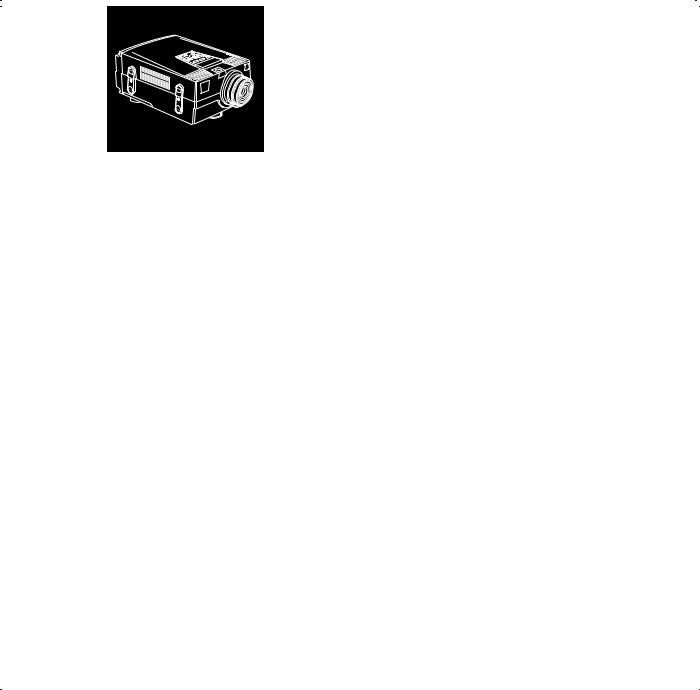
■ ■ ■ ■ ■ ■ ■ ■ ■ ■ ■ ■ ■ ■ ■
Contents
Introduction |
ix |
Getting the Most Out of Your Projector . . . . . . . . . . . . . . . . . . . . . . . . . . . . . . |
. .xi |
Optional Accessories . . . . . . . . . . . . . . . . . . . . . . . . . . . . . . . . . . . . . . . . . . |
. xii |
About This Manual . . . . . . . . . . . . . . . . . . . . . . . . . . . . . . . . . . . . . . . . . . . . . . . |
xiii |
Safety Instructions . . . . . . . . . . . . . . . . . . . . . . . . . . . . . . . . . . . . . . . . . . . . . . . . |
xiv |
Where to Get Help . . . . . . . . . . . . . . . . . . . . . . . . . . . . . . . . . . . . . . . . . . . . . . . |
xvi |
Electronic Support Services . . . . . . . . . . . . . . . . . . . . . . . . . . . . . . . . . . . . . . |
xvi |
Automated Telephone Services . . . . . . . . . . . . . . . . . . . . . . . . . . . . . . . . . . |
xvii |
1 Installation |
1 |
Unpacking the Projector . . . . . . . . . . . . . . . . . . . . . . . . . . . . . . . . . . . . . . . . . . . |
. 2 |
Additional Components . . . . . . . . . . . . . . . . . . . . . . . . . . . . . . . . . . . . . . . . |
. 3 |
Setting Up the Projector . . . . . . . . . . . . . . . . . . . . . . . . . . . . . . . . . . . . . . . . . . . . |
. 4 |
v

Connecting to a Computer . . . . . . . . . . . . . . . . . . . . . . . . . . . . . . . . . . . . . . . . . |
. .7 |
Connecting to a PC Desktop Computer . . . . . . . . . . . . . . . . . . . . . . . . . . . |
. .8 |
Connecting to a PC Laptop Computer . . . . . . . . . . . . . . . . . . . . . . . . . . . . . |
.12 |
Connecting to a Desktop Macintosh . . . . . . . . . . . . . . . . . . . . . . . . . . . . . . |
.16 |
Connecting to a PowerBook . . . . . . . . . . . . . . . . . . . . . . . . . . . . . . . . . . . . . |
.20 |
Connecting to a High-End Workstation . . . . . . . . . . . . . . . . . . . . . . . . . . . . |
24 |
Connecting to a Video Source . . . . . . . . . . . . . . . . . . . . . . . . . . . . . . . . . . . . |
24 |
Connecting to an External Speaker or PA System . . . . . . . . . . . . . . . . . . . . . . . . . |
27 |
2 Using the Projector |
29 |
About Your Projector . . . . . . . . . . . . . . . . . . . . . . . . . . . . . . . . . . . . . . . . . . . . . . |
30 |
Turning the Equipment On and Off . . . . . . . . . . . . . . . . . . . . . . . . . . . . . . . . . . |
31 |
Turning the Projector On and Off . . . . . . . . . . . . . . . . . . . . . . . . . . . . . . . . . |
31 |
Focusing and Positioning the Screen Image . . . . . . . . . . . . . . . . . . . . . . . . . . |
33 |
Controlling the Projector . . . . . . . . . . . . . . . . . . . . . . . . . . . . . . . . . . . . . . . . . . . |
36 |
Using the Remote Control . . . . . . . . . . . . . . . . . . . . . . . . . . . . . . . . . . . . . . . . . . |
37 |
Using the Control Panel . . . . . . . . . . . . . . . . . . . . . . . . . . . . . . . . . . . . . . . . . |
39 |
Projector Status Indicators . . . . . . . . . . . . . . . . . . . . . . . . . . . . . . . . . . . . . . . . . . |
41 |
3 Using the Projector Menus |
43 |
Accessing the Main Menu . . . . . . . . . . . . . . . . . . . . . . . . . . . . . . . . . . . . . . . . . . . |
44 |
Changing a Menu Setting . . . . . . . . . . . . . . . . . . . . . . . . . . . . . . . . . . . . . . . . . . . |
44 |
Menu Options . . . . . . . . . . . . . . . . . . . . . . . . . . . . . . . . . . . . . . . . . . . . . . . . . . . |
47 |
Video Menu (Image source = Computer) . . . . . . . . . . . . . . . . . . . . . . . . . . . . |
47 |
Video Menu (Image source = Video) . . . . . . . . . . . . . . . . . . . . . . . . . . . . . . . |
50 |
Audio Menu . . . . . . . . . . . . . . . . . . . . . . . . . . . . . . . . . . . . . . . . . . . . . . . . . . |
51 |
Options Menu . . . . . . . . . . . . . . . . . . . . . . . . . . . . . . . . . . . . . . . . . . . . . . . . |
52 |
Custom Menu . . . . . . . . . . . . . . . . . . . . . . . . . . . . . . . . . . . . . . . . . . . . . . . . |
54 |
vi

4 Using the ELP Link II Software |
59 |
Installing the Software . . . . . . . . . . . . . . . . . . . . . . . . . . . . . . . . . . . . . . . . . . . |
. . 60 |
Connecting Needed Cables . . . . . . . . . . . . . . . . . . . . . . . . . . . . . . . . . . . . |
. . 60 |
Installing the Software from Windows 3.x . . . . . . . . . . . . . . . . . . . . . . . . . . |
. 60 |
Installing the Software from Windows 95 |
|
and Windows NT 4.0 . . . . . . . . . . . . . . . . . . . . . . . . . . . . . . . . . . . . . . . . . |
. 62 |
Installing the Software from Macintosh OS |
|
System 7 or OS System 8 . . . . . . . . . . . . . . . . . . . . . . . . . . . . . . . . . . . . . . . |
. 63 |
Launching the Software . . . . . . . . . . . . . . . . . . . . . . . . . . . . . . . . . . . . . . . . . . . |
. 64 |
Using the Software . . . . . . . . . . . . . . . . . . . . . . . . . . . . . . . . . . . . . . . . . . . . . . . |
. 64 |
Customizing the Remote Control Effects Buttons . . . . . . . . . . . . . . . . . . . . |
. 64 |
Controlling Projector Features . . . . . . . . . . . . . . . . . . . . . . . . . . . . . . . . . . . |
. 72 |
5 Maintenance |
81 |
Cleaning the Lens . . . . . . . . . . . . . . . . . . . . . . . . . . . . . . . . . . . . . . . . . . . . . . . . |
. 82 |
Cleaning the Projector Case . . . . . . . . . . . . . . . . . . . . . . . . . . . . . . . . . . . . . . . . |
. 82 |
Cleaning the Air Filter . . . . . . . . . . . . . . . . . . . . . . . . . . . . . . . . . . . . . . . . . . . . |
. 83 |
Replacing the Lamp . . . . . . . . . . . . . . . . . . . . . . . . . . . . . . . . . . . . . . . . . . . . . . |
. 84 |
6 Troubleshooting |
87 |
Problems with the Projector . . . . . . . . . . . . . . . . . . . . . . . . . . . . . . . . . . . . . . . . |
. 88 |
Problems with the Image or Sound . . . . . . . . . . . . . . . . . . . . . . . . . . . . . . . . . . |
. 90 |
7 Technical Specifications |
93 |
Supported Monitor Displays . . . . . . . . . . . . . . . . . . . . . . . . . . . . . . . . . . . . |
. 96 |
Glossary |
99 |
Index |
101 |
vii

viii
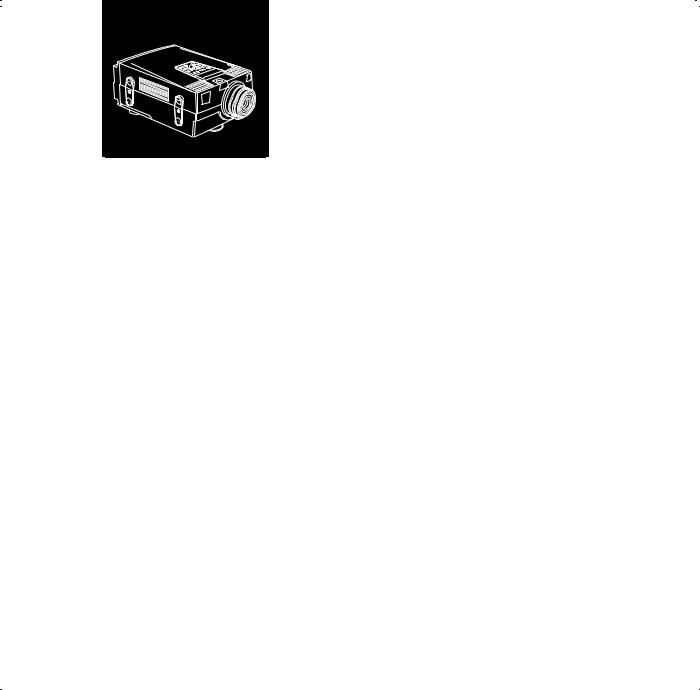
■ ■ |
■ |
■ ■ ■ ■ ■ ■ ■ ■ ■ ■ ■ ■ |
Introduction |
|
|
The EPSON® PowerLite™ 7000XB and PowerLite 5000XB are compact, lightweight projectors that allow you to project full-color images and video onto a large screen for presentations. You can connect either projector simultaneously to three image sources: two PC or Apple® Macintosh® computer image sources plus one video source, such as a VCR or camcorder. You can also connect audio for each image source.
If you have a PowerLite 7000XB, images are displayed in XGA compatible full color (16,670,000 colors) at a resolution of 1024 x 768 pixels. The PowerLite 5000XB displays images in SVGA compatible full color at a resolution of 800 x 600 pixels. Your projector produces bright images that can be easily seen in rooms light enough to take notes.
ix

Your projector’s two speakers employ a built-in Spatializer 3D Sound System for rich, powerful audio output. You can even connect an external speaker when further amplification is required.
A totally new, patent pending AVTSS system (Automatic Video Tracking and Synchronization Sensing) provides automatic image setup from a computer with a touch of a button, producing beautiful images quickly and easily.
You control your projector through a hand-held remote control unit, with menus provided for image source switching and image adjustment. The remote control can also act as a wireless mouse to control operations on your computer screen during presentations. The projector’s ELP Link II software provides a number of add-on features designed to make presentations more effective.
Your projector also features a new patented SizeWise chip for support of VGA and SXGA output (PowerLite 7000XB) or VGA and XGA output (PowerLite 5000XB). No matter what type of computer output is used, the result is a full-size video image of outstanding clarity.
Both the PowerLite 7000XB and PowerLite 5000XB support IBM® compatible PCs and laptops, as well as Apple Macintosh, Power Macintosh,™ and PowerBook™ computers. The video source can be NTSC, PAL, or SECAM in composite video or S-Video format.
x |
Introduction |

Getting the Most Out of Your Projector
Your projector comes with a full set of features that enable you to control the settings for the image display, video, and audio. To get the most out of the projector, read this section for a quick summary of the important features.
Remote Control
The buttons on the remote control enable you to turn the projector on and off, and provide direct access to auto set up, blank, freeze, volume, mute, and image source switching. Use the remote control buttons to access custom functions (with the ELP Link II software) and the projector’s menu system. You can even use the remote control to control your computer in place of your computer’s mouse.
Sleep Mode
Sleep mode conserves electricity by automatically turning off the lamp after the projector has not been used for 30 minutes. In sleep mode, the projector remains on but the lamp is turned off, conserving electricity, cooling the projector, and extending the life of the lamp.
Control Panel
The control panel buttons on the projector duplicate the remote control buttons and let you perform additional functions, such as adjusting the tracking and sync for computer images.
Getting the Most Out of Your Projector |
xi |

Optional Accessories
To enhance your use of the projector, EPSON provides the following accessories:
●Carrying cases especially designed for the projector and its cables.
Hard Carrying Case |
ELPKS06 |
Wheeled Soft Carrying Case |
ELPKS07 |
Soft Carrying Case |
ELPKS08 |
●Replacement lamp and air filter.
Lamp with Filter |
ELPLP04 |
●Remote control receiver module with a cable for rear and ceiling mount projection. The infrared receiver allows wireless remote control at up to 32.8 feet (10 meters).
Remote control receiver module ELPST02
●Communication cable set and computer cable so you can connect your projector to a second computer. Also add a MAC adapter set to connect to a second Macintosh, or a video cable to connect the projector to a video source that supports S-Video.
ELP communication cable set |
ELPKC04 |
MAC adapter set |
2023359 |
VGA-13WS video cable |
ELPKC06 |
VGA-BNC video cable |
ELPKC07 |
You can purchase these accessories from your dealer or by calling
EPSON Accessories at (800) 873-7766.
xii |
Introduction |

About This Manual
Chapter 1, “Installation,” gives step-by-step instructions on how to set up your projector and connect it to your computer, video source, or other optional equipment. Read the installation procedures that apply to your environment.
Chapter 2, “Using the Projector,” describes how to turn on the projector and control simple projector settings using the remote control or the operation panel.
Chapter 3, “Using the Projector Menus,” describes how to use the menus to adjust the color and image settings, change the display of the projected image, and modify audio settings such as bass and treble.
Chapter 4, “Using the ELP Link II Software,” describes how to use the ELP Link II software to control the computer and use the special presentation functions.
Chapter 5, “Maintenance,” describes how to maintain your projector in good working order.
Chapter 6, “Troubleshooting,” describes how to interpret your projector’s warning lights and gives helpful information for avoiding errors, optimizing image quality, and solving problems.
Chapter 7, “Technical Specifications,” lists the technical specifications for both the PowerLite 7000XB and PowerLite 5000XB projectors.
About This Manual |
xiii |

Safety Instructions
Follow these safety instructions when setting up and using the projector:
1.Do not place the projector on an unstable cart, stand, or table.
2.Do not use the projector near water or sources of heat.
3.Use attachments only as recommended.
4.Use the type of power source indicated on the projector. If you are not sure of the power available, consult your dealer or power company.
5.Place the projector near a wall outlet where the plug can be easily unplugged. Placez l’imprimante près d’une prise de contacte où la fiche peut être débranchée facilement.
6.Insert the projector’s three-wire grounding-type plug into a properly grounded outlet. If you have a two-prong outlet, contact an electrician to replace it. Do not hold the plug with wet hands.
7.Take the following precautions for the plug. Failure to comply with these precautions could result in sparks or fire.
●Do not insert the plug into an outlet with dust present.
●Insert the plug firmly into the outlet.
8.Do not overload wall outlets, extension cords, or integral convenience receptacles. This can cause fire or electric shock.
9.Do not place the projector where the cord can be walked on. It may result in fraying or damage to the plug.
xivIntroduction

10.Unplug the projector from the wall outlet before cleaning. Use a damp cloth for cleaning. Do not use liquid or aerosol cleaners.
11.Do not block the slots and openings in the projector case. They provide ventilation and prevent the projector from overheating. Do not operate the projector on a sofa, rug, or other soft surface, or in a closed-in cabinet unless proper ventilation is provided.
12.Never push objects of any kind through cabinet slots. Never spill liquid of any kind into the projector.
13.Except as specifically explained in this User’s Guide, do not attempt to service this product yourself. Refer all servicing to qualified service personnel. Opening or removing covers may expose you to dangerous voltages and other hazards.
14.Unplug the projector during lightning storms or when it will not be used for extended periods.
15.Do not place the projector and remote control on top of heat-producing equipment or in a heated place, such as a car.
16.Unplug the projector from the wall outlet and refer servicing to qualified service personnel under the following conditions:
●When the power cord or plug is damaged or frayed
●If liquid has been spilled into the projector, or if it has been exposed to rain or water
●If it does not operate normally when you follow the operating instructions, or if it exhibits a distinct change in performance, indicating a need for service
●If it has been dropped or the housing has been damaged
Safety Instructions |
xv |

Where to Get Help
EPSON provides customer support through the following services:
Electronic Support Services
You can access helpful tips, specifications, DIP switch or jumper settings, drivers, Frequently Asked Questions (FAQs), sample files, application notes, and EPSON product bulletins 24 hours a day, 7 days a week, using a modem and one of the on-line services below.
World Wide Web
From the Internet, you can reach EPSON’s Home Page at
http://www.epson.com
EPSON Internet FTP Site
If you have Internet FTP capability, use your Web browser (or other software for FTP downloading) to log onto ftp.epson.com with the user name anonymous and your e-mail address as the password.
EPSON Download Service
You can call the EPSON Download Service at (800) 442-2007. Set your communications software to 8 data bits, 1 stop bit, no parity. Modem speed can be up to 28.8 Kbps.
xvi |
Introduction |

EPSON Forum on CompuServe®
Members of CompuServe can type GO EPSON at the menu prompt to reach CompuServe’s Epson America Forum. As an owner of an EPSON product, you are eligible for a free introductory CompuServe membership, which entitles you to an introductory credit and your own user ID and password. To take advantage of this offer in the U.S. or Canada, call (800) 848-8199 and ask for representative #529
Automated Telephone Services
EPSON FaxAdvice™
You can access EPSON’s technical information library by calling (800) 442-2110 and selecting the appropriate phone option. You must provide a return fax number to use EPSON FaxAdvice.
EPSON SoundAdvice™
For pre-recorded answers to commonly asked questions about EPSON products 24 hours a day, seven days a week, call (800) 442-2110.
EPSON also provides technical support and information on the installation, configuration, and operation of EPSON products. Dial
(800) 922-8911, (310) 782-2600 (U.S.), or (905) 709-9475
(Canada), 6 A.M. to 6 P.M., Pacific Time, Monday through Friday.
Where to Get Help |
xvii |

Before you call, please have the following information ready:
●Product name
●Product serial number
●Computer configuration
●Description of the problem
You can purchase ink cartridges, paper, manuals, accessories, and parts from EPSON Accessories at (800) 873-7766 (U.S. sales only). In Canada, please call (800) 873-7766 for dealer referral..
Note:
If you need help using software with an EPSON product, see the documentation for that program for technical support information.
xviii |
Introduction |
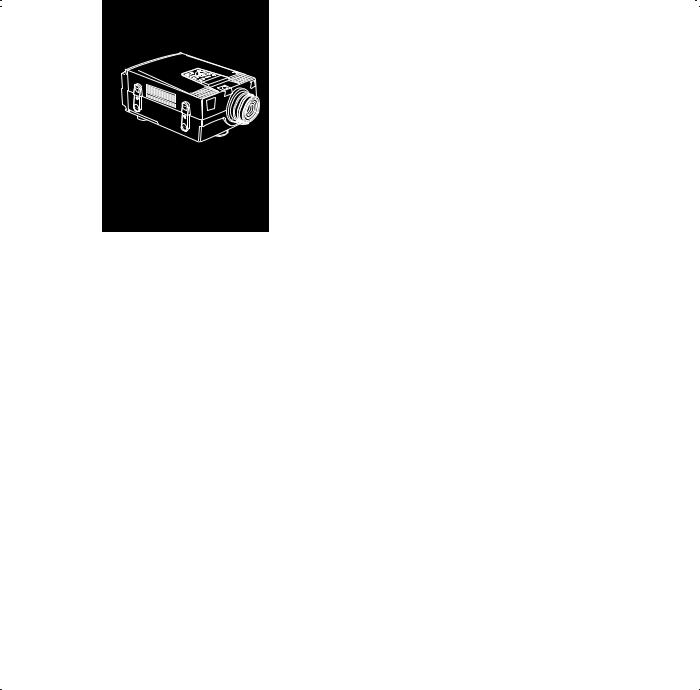
■ |
■ |
■ |
■ ■ ■ ■ ■ ■ ■ ■ ■ ■ ■ ■ |
1 |
|
|
|
Installation |
|
|
|
This chapter describes how to unpack, set up, and connect your projector to other equipment. The projector must be connected to a computer or a video source such as a VCR, camcorder, or laser disc player. For example, you may want to connect the projector to both your computer and a video source, or set up the projector for one or more of the following:
●Connect the mouse cable to use the remote control as a wireless mouse.
●Provide audio for one or both image sources. The audio source can be the computer, video source, or another device such as a stereo.
●Connect to an external speaker or PA system to amplify the audio.
1

Unpacking the Projector
When you unpack the projector, make sure you have all these components:
●Projector
●Lens cover
●Remote control
●2 AA batteries
●Power cord
●Video cable
●
●
●
Audio cable
Audio/visual (A/V) cable
Macintosh adapter set
Macintosh desktop adapter |
Macintosh monitor adapter |
● ELP Link II Kit |
|
Main cable |
PC serial cable |
Mouse cable for PS/2 |
Macintosh serial cable |
Mouse cable for serial |
Diskette for Windows |
Mouse cable for Macintosh |
Diskette for Macintosh |
Depending on the configuration of your equipment, you may not need all these components.
Save all packaging in case you need to ship the projector in the future. Always transport the projector in its original packaging or the equivalent.
2 |
1 • Installation |

Additional Components
Depending on how you plan to use the projector, you may need additional components:
●To receive an S-Video signal, you need an S-Video cable. (One is usually provided with your video device.) A separate cable is required for each video source.
●To connect a second computer, you need a video and audio cable.
●To connect the projector to a Macintosh PowerBook, you need a video-out cable. (One is provided for all new PowerBooks that have video-out capability.) If your PowerBook does not include one, see your Macintosh dealer.
●To connect the projector to an external sound system, you need an RCA-to-3.5 mm stereo audio cable. You can obtain one from your computer dealer.
●To connect the mouse cable to your computer, you may require a special connector, cable, or other components. You can obtain these items from your computer dealer.
Note: You can connect a Kensington MicroSaver anti-theft device in the hole on the right side of the projector. Contact your local computer dealer.
Unpacking the Projector |
3 |

Setting Up the Projector
1.Place the projector on a sturdy, level surface within five feet of the computer or video source.
Caution: Do not hold the projector by the lens. This can damage the lens.
2.Place the projector the proper distance from the screen.
The distance between the projector and the screen determines the actual image size. Use the general guidelines in the table on the next page to determine the proper distance.
4 |
1 • Installation |

|
Horizontal distance from projector to screen |
|
Image size (diagonal) |
Minimum |
Maximum |
|
|
|
300 inches |
32.8 feet (10 m) |
|
200 inches |
22 feet (6.7 m) |
28.5 feet (8.7 m) |
100 inches |
10.8 feet (3.3 m) |
14 feet (4.3 m) |
80 inches |
8.9 feet (2.7 m) |
11.5 feet (3.5 m) |
60 inches |
6.6 feet (2 m) |
8.5 feet (2.6 m) |
40 inches |
4.3 feet (1.3 m) |
5.6 feet (1.7 m) |
30 inches |
3.3 feet (1 m) |
4.3 feet (1.3 m) |
23 inches |
|
3.3 feet (1 m) |
|
|
|
3.Make sure the projector is at a right angle to the screen. Otherwise, the screen image will be distorted.
4.Connect one end of the power cord to the projector’s power connector. Connect the other end to a grounded electrical outlet. The projector goes into sleep mode, indicated by the orange power status light.
Warning: Never look into the lens when the lamp is on. The projector might come on suddenly, even when it is not operating. This can damage your eyes. It is especially important that children not look into the lens.
Setting Up the Projector |
5 |
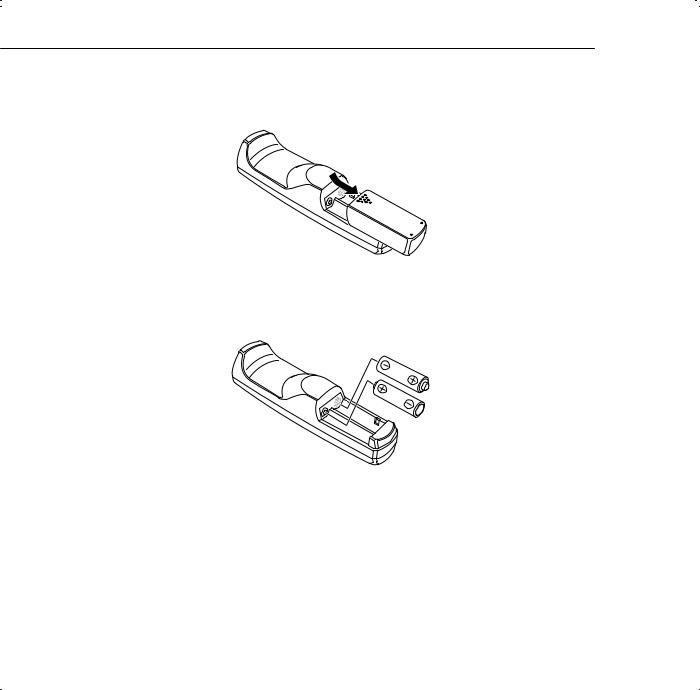
5.To insert the batteries in the remote control, slide off the battery compartment cover as shown here
6.Insert the two AA batteries included with the projector. Make sure the polarity of the batteries is correct.
|
|
TITLE |
|
|
EPSON AMERICA, INC. |
35 |
_BATT1.eps |
|
Documentation Department |
DATE |
|
|
20770 Madrona Avenue, Torrance, CA 90503 |
27 |
August 1996 |
|
(310) 782-0770 |
DRAWN BY |
|
|
|
Wendi Swanlund |
|
|
|
|
|
7. Replace the battery compartment cover.
6 |
1 • Installation |

When replacing batteries, take the following precautions:
●Do not mix old and new batteries.
●Replace batteries as soon as they run out. If the batteries leak, wipe away battery fluid with a soft cloth. If fluid gets on your hands, wash them immediately.
●Remove batteries if you will not be using the projector for a long period of time.
Connecting to a Computer
You can connect the projector to any computer capable of standard VGA, Super VGA, XGA, or Super XGA output, including:
●IBM compatible desktop PC
●IBM compatible laptop PC
●Apple Macintosh desktop computer, including Macintosh Quadra,® Macintosh Centris,® and Power Macintosh
●Any Apple PowerBook with video-out capability. This includes all 160, 165, 180, and 500 series PowerBooks.
See the section that applies to your computer.
Connecting to a Computer |
7 |
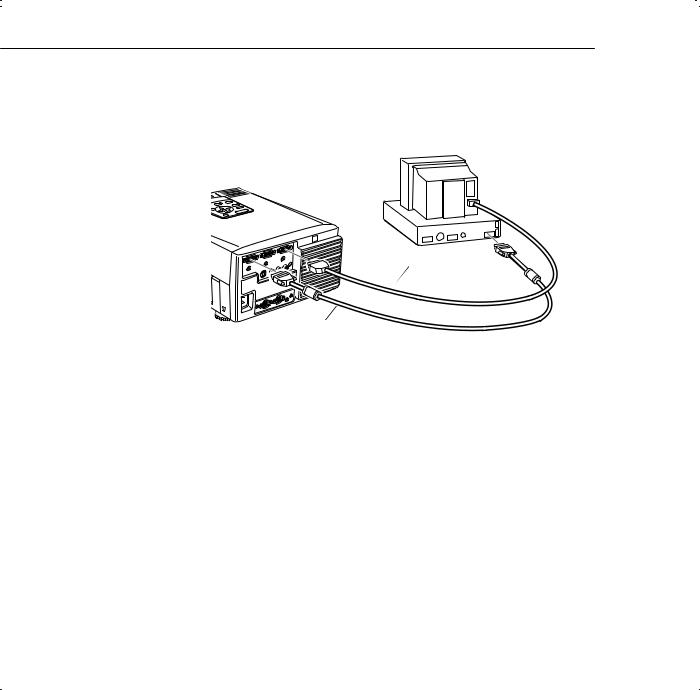
Connecting to a PC Desktop Computer
Before beginning, turn off the projector and computer if they are on.
1. Connect the video cable.
monitor cable
video cable
Note: Computer configurations vary. See your computer manual for the location of the ports needed to connect your projector.
a.Connect one end of the video cable to the projector’s Computer In 1 port. (Use the Computer In 2 port if you are connecting a second computer.)
b.Disconnect the computer monitor cable from the video port on the back of the computer, and connect the other end of the video cable to the computer’s video port.
8 |
1 • Installation |
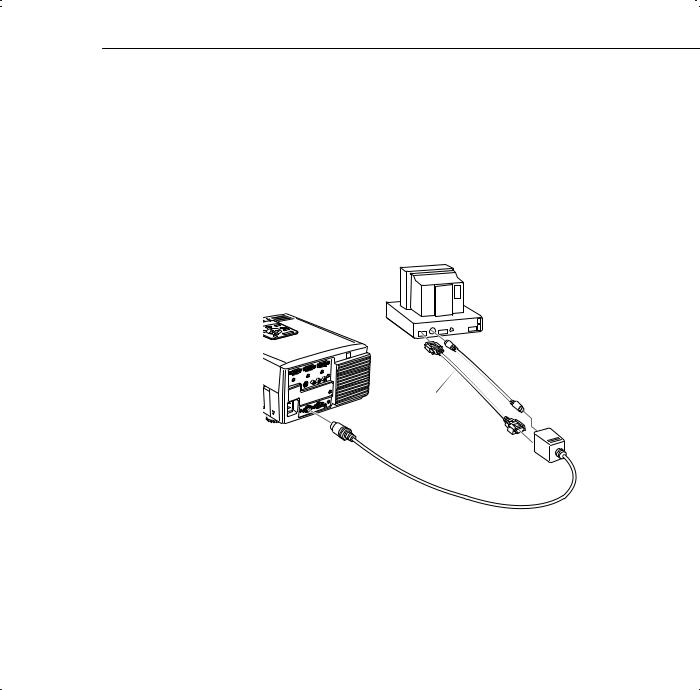
c.To also view the video on the computer monitor, connect the computer monitor’s monitor cable to the projector’s Monitor port. This is useful when you need to view the video output but the projection screen is behind you.
d.Tighten the screws on all connectors.
2.Connect the main cable. The main cable connects the PS/2 mouse cable (needed to use the remote control as a mouse) and 9-pin serial cable (needed to use the ELP Link II software and the Effects buttons on the remote control) from your computer to the projector.
PS/2 mouse cable
9-pin serial cable
main cable
EPSON/PowerLite 5000 - File: SRMS-PC.eps
W. Swanlund MOD> 12/16/96
Connecting to a Computer |
9 |

a.Connect the small end of the main cable to the projector’s Mouse/Com 1 port. (Use the Mouse/Com 2 port if you are connecting a second computer.)
b.Connect one end of the PS/2 mouse cable included with the projector to the mouse terminal on the square end of the main cable.
c.Disconnect the computer’s PS/2 mouse cable from the mouse port on the back of your computer and replace it with the other end of the mouse PS/2 mouse cable included with the projector.
d.If your system uses a serial mouse, perform steps b and c using the serial mouse cable instead of the PS/2 mouse cable (not shown in the illustration).
e.To configure the projector from your PC using the
ELP Link II software or to use the Effects buttons on the remote control, connect one end of the serial cable to the serial terminal on the square end of the main cable.
f.Connect the other end of the serial cable to the serial port on the back of your computer.
Note: You will not be able to use ELP Link II software if your system has only one serial port that is being used to support a serial mouse.
g.Tighten the screws on all connectors to make sure they are fastened securely.
10 |
1 • Installation |
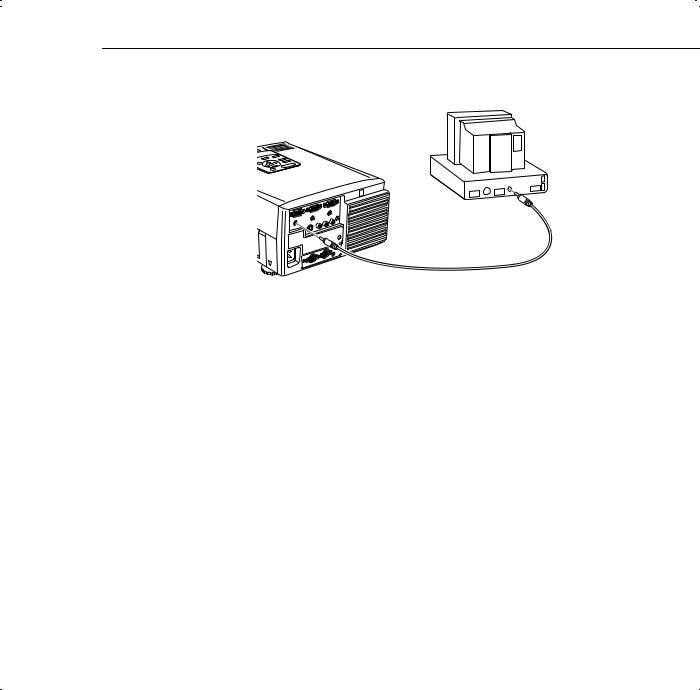
3. Connect the audio cable if needed.
a.Connect one end of the audio cable to the Audio In 1 jack on the projector. (Use the Audio In 2 jack if you are connecting a second computer).
b.Connect the other end of the audio cable to the speaker or audio out port on a sound card in the computer.
Connecting to a Computer |
11 |
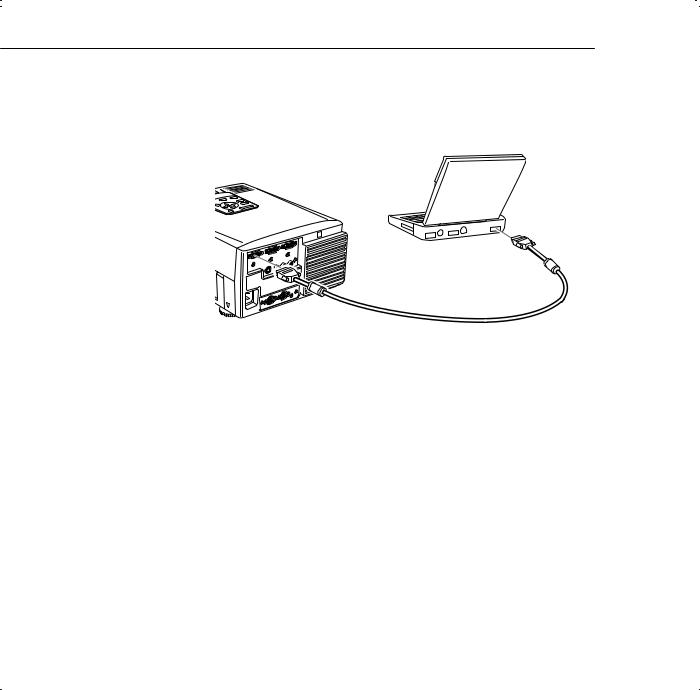
Connecting to a PC Laptop Computer
Before beginning, turn off the projector and computer if they are on.
1. Connect the video cable.
Note: Laptop configurations vary. See your computer manual for the location of the ports needed to connect your projector.
a.Connect either end of the video cable to the projector’s Computer In 1 port. (Use the Computer In 2 port if you are connecting a second computer.)
b.Connect the other end of the video cable to the laptop’s video (monitor) port.
c.Tighten the screws on all connectors to make sure they are fastened securely.
12 |
1 • Installation |
